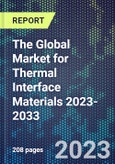The effective transfer/removal of heat from a semiconductor device is crucial to ensure reliable operation and to enhance the lifetime of these components. The development of high-power and high-frequency electronic devices has greatly increased issues with excessive heat accumulation. There is therefore a significant requirement for effective thermal management materials to remove excess heat from electronic devices to ambient environment.
Thermal interface materials (TIMs) offer efficient heat dissipation to maintain proper functions and lifetime for these devices. TIMs are materials that are applied between the interfaces of two components (typically a heat generating device such as microprocessors, photonic integrated circuits, etc. and a heat dissipating device e.g. heat sink) to enhance the thermal coupling between these devices. A range of Carbon-based, metal/solder and filler-based TIMs are available both commercially and in the research and development (R&D) phase.
Report contents include:
- Analysis of recent commercial and R&D developments in thermal interface materials (TIMs).
- Market trends and drivers.
- Market map.
- Analysis of thermal interface materials (TIMs) including:
- Thermal Pads/Insulators.
- Thermally Conductive Adhesives.
- Thermal Compounds or Greases.
- Thermally Conductive Epoxy/Adhesives.
- Phase Change Materials.
- Metal-based TIMs.
- Carbon-based TIMs.
- Market analysis. Markets covered include:
- Consumer electronics.
- Electric Vehicles (EV) batteries.
- Data Center infrastructure.
- ADAS sensors.
- EMI shielding.
- 5G.
- Global market revenues for thermal interface materials (TIMs), segmented by type and market, historical and forecast to 2033.
- Profiles of 87 producers. Companies profiled include Arieca, Carbice Corporation, CondAlign, Fujipoly, Henkel, Indium Corporation, KULR Technology Group, Inc., Parker-Hannifin Corporation, Shin-Etsu Chemical Co., Ltd, and SHT Smart High-Tech AB.
This product will be delivered within 1-3 business days.
Table of Contents
Companies Mentioned (Partial List)
A selection of companies mentioned in this report includes, but is not limited to:
- 3M
- AI Technology Inc.
- AOK Technologies
- AOS Thermal Compounds LLC
- Aismalibar S.A.
- Arkema
- Arieca, Inc.
- ATP Adhesive Systems AG
- Bando Chemical Industries, Ltd
- BNNano
- BNNT LLC
- Boyd Corporation
- BYK
- Carbice Corp.
- Carbon Waters
- Carbodeon Ltd. Oy
- CondAlign AS
- Detakta Isolier- und Messtechnik GmbH & Co. KG
- Dexerials Corporation
- Deyang Carbonene Technology
- Dow Corning
- Dupont (Laird Performance Materials)
- Dymax Corporation
- ELANTAS Europe GmbH
- Elkem Silcones
- Enerdyne Thermal Solutions, Inc
- Epoxies Etc.
- First Graphene Ltd
- Fujipoly
- Fujitsu Laboratories
- GLPOLY
- Global Graphene Group
- Goodfellow Corporation
- Graphmatech AB
- GuangDong KingBali New Material Co., Ltd.
- HALA Contec GmbH & Co. KG
- Hamamatsu Carbonics Corporation
- H.B. Fuller Company
- Henkel AG & Co. KGAA
- Honeywell
- Hongfucheng New Materials
- HyMet Thermal Interfaces SIA
- Indium Corporation
- Inkron
- Kerafol Keramische Folien GmbH & Co. KG
- Kitagawa
- KULR Technology Group, Inc.
- Leader Tech Inc.
- LiSAT
- Liquid Wire, Inc.
- MG Chemicals Ltd
- Minoru Co., Ltd.
- Mithras Technology AG
- Molecular Rebar Design, LLC
- Momentive Performance Materials
- Nanoramic Laboratories
- Nano Tim
- NeoGraf Solutions, LLC
- Nolato Silikonteknik
- Ntherma Corporation
- OCSiAl Group
- Panasonic
- Parker Hannifin Corporation
- Plasmonics, Inc.
- Polymer Science, Inc.
- Polytec PT GmbH
- Protavic
- Ray-Techniques Ltd.
- Rovilus, Inc.
- Saint-Gobain
- Samyang Corporation
- Schlegel Electronic Materials
- Sekisui Chemical
- Sekisui Polymatech Europe BV
- Shenhe Liyang Technology
- Shinko Electric Industries Co., Ltd.
- Shin-Etsu Chemical Co. Ltd.
- SHT Smart High Tech AB
- Sika AG
- Sixth Element
- STOCKMEIER Urethanes GmbH & Co. KG
- Suzhou Kanronics Electronic Technology Co., Ltd
- Tenutec AB
- Versarien
- Wacker Chemie AG
- Zalman Tech Co., Ltd.
- Zeon Specialty Materials
Methodology

LOADING...








